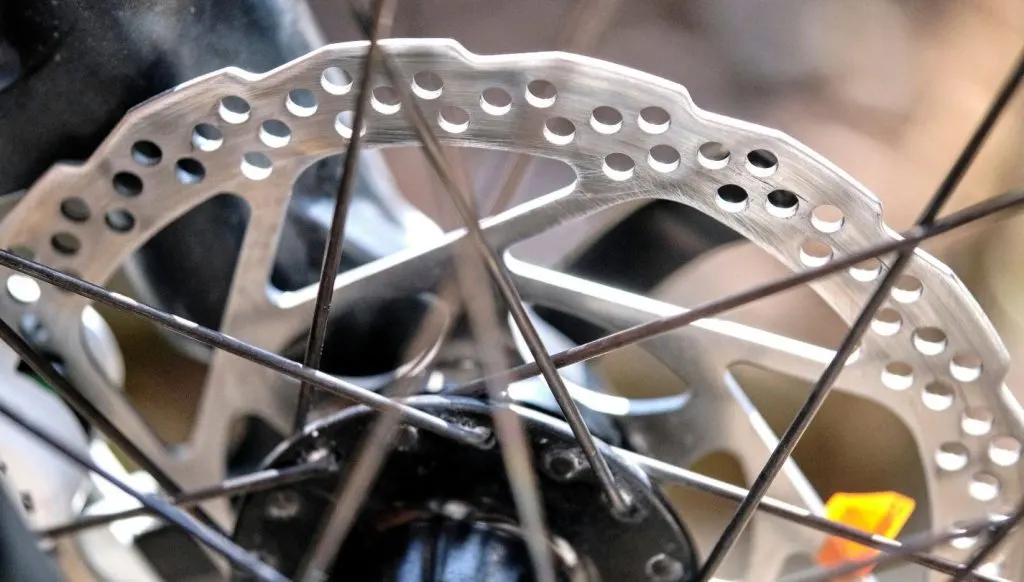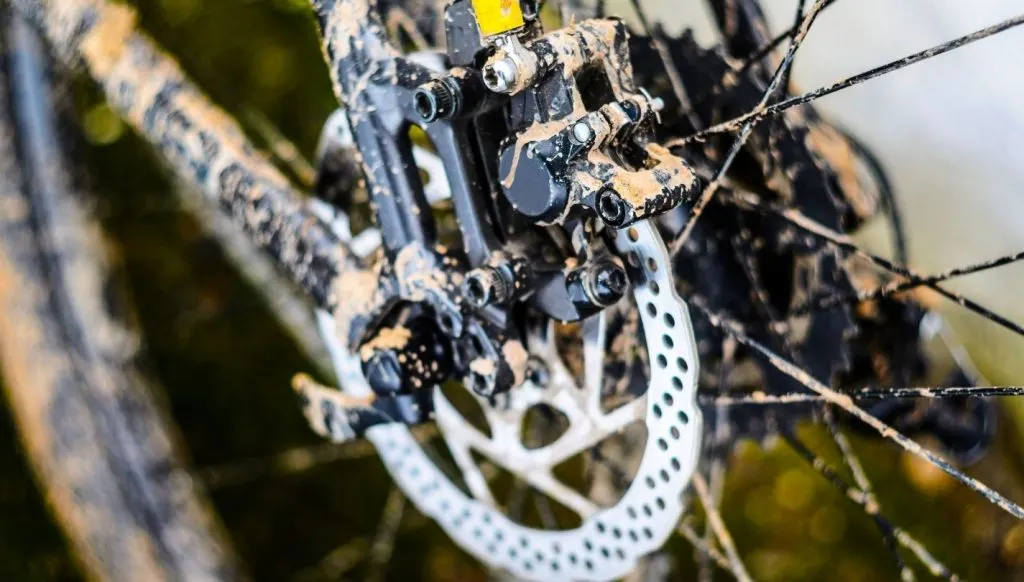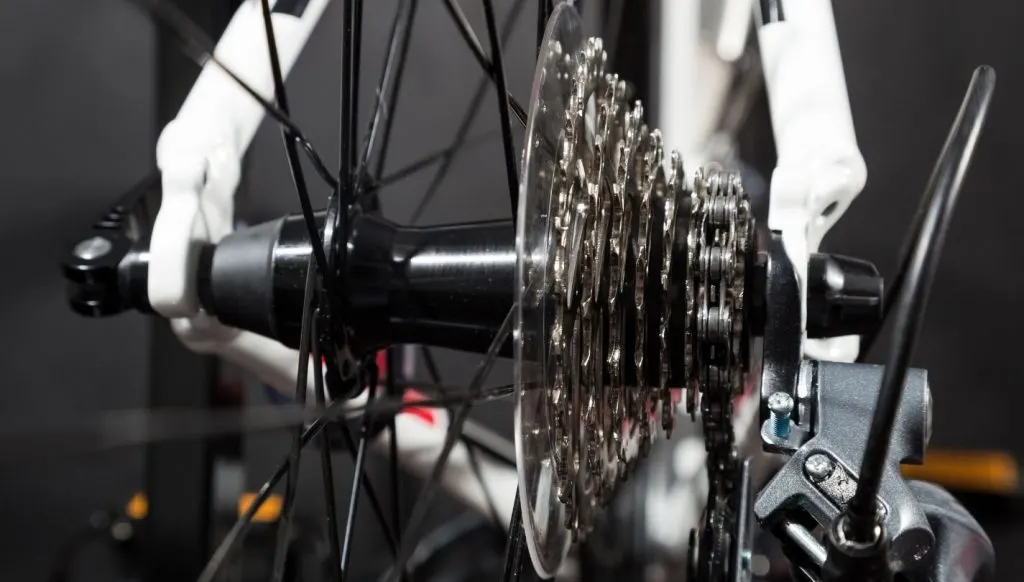
As more and more riders switch to disc brakes and more bicycles are produced with disc brakes, the question of what size the rotors should be is becoming more relevant. Can you put bigger rotors on your bike? The answer to this question is yes.
You can put bigger rotors on your bicycle. As with anything to do with bikes and braking, putting bigger rotors on your bike is not a simple, straightforward answer. Several considerations need to be taken into account before taking this decision.
From riding weight and where and how you ride, to the front and back rotor size configuration, these are the aspects you will need to consider before fitting bigger rotors. Let’s discuss in more detail what you need to consider before choosing to go with bigger rotors…
The Conversation Around Rotor Size Best Practice
When disc brakes originally emerged, the standard thoughts around rotors were larger in front and smaller at the back. The logic around this was that when braking, it’s the front brake that usually activates first and then the back brake.
While this was true, this perspective didn’t consider the extended braking that the back rotor had to deal with on downhill runs and other descents.
Then the idea of even-sized rotors front and back took hold, and people started to change to this configuration. The discussion is changing to having a larger rotor on the back and a slightly smaller one on the front.
Why is this? Why has the perspective on rotors changed since their introduction? Like most things that change over time, it’s a result of experience in the field, specifically concerning safety in braking.
Cycling Faster Means you Have to Be Able to Stop Faster Too!
Riding fast is exciting, exhilarating, and what many riders on both road and mountain bikes live for! With speed comes the opposite – braking and being able to slow down quickly and safely. This can often mean the difference between finishing the race on your bike or taking a short trip in an ambulance!
Disc brakes on a mountain bike experience extreme forces under braking, and many of them are not up to the task. Many manufacturers look to save weight using smaller rotors and specifying lighter brakes.
Adding bigger rotors to your back and front brakes bring more braking power, while the weight added is negligible in terms of performance impact.
If you weigh upward of 176lbs or do extended downhill riding, then when you’re done, take a look at the color of your rotors, especially the back one. In most cases, the rear rotor takes most of the braking brunt, while the front rotor usually keeps its silver color.
The Real Dynamics Of Braking on a Bicycle
To understand the effect of rotor size on your braking, you need to know only a little bit about braking dynamics.
To start with, many would argue that you require more braking force in the front than at the back and, when you are short braking into corners, the brake force distribution is about 70% to the front and 30% to the back.
But the overheating and wear caused to the rear rotor doesn’t happen on those short sharp breaking runs; they happen on the long downhill descents where you may not realize the amount of time you spend on that back brake.
The brakes are the ONLY thing that can slow you down on a bike, while on a car or motorbike, you have engine braking that assists with deceleration.
While riding, the back brake is used to maintain, and control speed as the front wheel is involved in the steering and control of the bike. Because of this, the heat resulting from this braking is primarily transferred to the back rotor.
Now, if you do primarily flat riding on your mountain bike – which is very, very unlikely considering the nature of the sport – then you can get away with a larger rotor front and smaller ones on the back, or even sizes on each.
However, since this is unlikely, you would want a bigger rotor on the back and a slightly smaller one on the front.
Why Don’t Bike Dealers Push Larger Back Rotors?

With all of this in mind, why don’t bike dealers recommend larger rotors or sell bikes with larger rotors?
There are some reasons for this, the first of which is the weight. When buying and gearing up their bikes, many customers are guilty of ‘scale watching’ – i.e., they will watch every gram on the bike, and larger rotors are heavier.
But not by very much.
- An SRAM Centerline 180mm rotor weighs about 151g.
- A 200mm rotor weighs in at 207g.
This is a difference of just 56grams. An increase from a 200mm rotor at 207g to a 220mm rotor at 223g is just 16g!
Now, let’s be realistic about this additional weight and impact on riding performance.
If you added 56 grams to your riding gear, would you notice, and would it have any noticeable and measurable impact on your performance? If you added 16 grams as an amateur weekend rider or even as a competitive rider, the effect of this weight would be negligible at best.
So when it comes to the ‘nit-picking’ on adding weight, the focus needs to shift from the minuscule weights of bigger rotors to the impact of accessories that add considerably more weight to the bike.
The Effect of Larger Back Rotors On Braking Surface
Now, let’s look at the effect of the bigger surface area of the larger rotors and their impact on the braking power on your bike.
- Increasing the rotor size from 180mm to 200mm adds an additional 11% to the braking surface.
- Increasing the size from 180mm to 220mm is an increase of 24%.
The increase of rotor size adds around 10% braking power and, according to SRAM, reduces the temperature by a staggering 39°c or 102°F!
Would you rather have 10% more braking power and less wear and tear on your back rotor as a rider’s choice? Going downhill at speed or having the secure peace of mind KNOWING you have greater braking force would be worth the 56g or 16g extra weight!
Front Wheel Rotors – What You Should Be Considering
What should you be looking at for the front rotors with larger rear rotors for increased braking power? The rising opinion, especially with Mountain bikes and Trail bikes, is that a smaller rotor on the front is the better option.
Firstly, many front forks are not built to accommodate larger rotors yet, and for this reason, you may not be able to fit larger ones even if you wanted to. Having said that, there is no reason to have a larger or equal size front rotor compared to the back one.
As many front forks are not approved for larger rotors, they will struggle to handle the braking force, which may cause some creaking – not necessarily something you want to hear when riding!
The front wheel is where the control is for cornering and steering, and while the front brake does play a role in short braking, it doesn’t have nearly the workload that the rear rotor has.
For the front rotor, consider your weight and riding terrain, but for the most part, a 200mm / 220mm split front/rear is a great configuration. The additional power on the back adds braking force and the smaller front rotor gives better modulation.
Another strong argument for the larger rotors is that you need less arm force to pull the brakes as you don’t need to pull on them as hard as you would with smaller rotors. This allows for less exertion in the arms, and so you get less tired.
In essence, you get the same braking force with the larger rotors but with ‘less squeeze .’ In a sport where every drop of energy counts, braking efficiently using less energy is always a better option.
Bigger Rotors Dissipate Heat Better

The larger surface area of the larger rotors offers greater heat dissipation. This will lessen the risk of your brake fluid or pad material boiling. This is certainly not ideal when riding.
When considering the investment in larger rotors, consider the cost to replace frequent wear and tear caused by heat on the brake system components. The more efficient heat dispersion and capacity of larger rotors will save money on component replacements.
Also, the braking performance drops with a large build-up of heat because as the heat builds on the rotors, the friction between rotors and pads reduces, leading to decreased braking ability.
The larger the rotors, the better they can store and manage the heat. And the better the heat management in the rotors, the brake pads and hose fluid will remain at optimum operational temperature.
Again, not something you would want to worry about or contend with while riding downhill at breakneck speed. You REALLY want to know that you will get every ounce of braking power when you need it.
Bigger Rotors Deliver More Braking Torque
Where the brake caliper is further away from the wheel center; it delivers more torque on the brake squeeze than if it was closer. To understand this better, try pushing a door open from near the hinge and see how much force you need to do that.
Now, push that same door open from the handle. It requires a lot less force to do. The same principle applies to braking.
The further away the caliper is from the wheel center, the more torque it can deliver and so can brake with less effort on the part of the rider.
Less force required for braking translates into more control, and more control when braking at high speed is ALWAYS a good thing to have, especially on those Alpine Hill down runs!
Brake Pad Choices For Front And Back Rotors
If you think about the type of braking you’ll be doing when riding, aside from the rotor sizes, the other consideration is the brake pad material that will work best.
A softer, more organic brake pad for the front would be optimal as this allows for more control as they bite faster and give smoother braking for better modulation. In contrast, a tougher material like steel pads would provide better resistance to heat on the rear.
Remember, the more heat your rotors can effectively manage, the more consistent and effective your braking will be, so the consideration needs to cover all the aspects of your riding.
When Larger Rotors Wouldn’t Be Suitable
The real benefit of upgrading to larger rotors is evident for heavier riders looking to do more downhill racing as the kinetic energy combination of more weight and speed requires stronger braking systems.
However, larger rotors are not always suitable, such as on flatter trails with less dust. They can be too strong! Remember that your choice of rotor size will be primarily determined by the type of riding you do.
If you are riding more flowing trails with lower grade descents and you aren’t really speeding downhill, changing your rotors may not be of any real benefit.
Having control while braking is more important than flat out braking power, as even a slight pull on the brake while riding will yield some immediate and tangible response.
Front-wheel lockup under braking, results in a loss of control, which increases the chances of a crash in technical terrain conditions. Once again, it comes to a ‘horses for courses’ type of evaluation.
Road Bikes Are Now Using Disc Brakes
For the longest time and before 2021, the mere suggestion of disc brakes on a road bike was met with great resistance and negativity. Fast forward to 2021, and pretty much all of the tour bike teams are using disc brakes.
The point of this is that road riders have come to realize that disc braking systems deliver more braking power, and in road racing, like mountain biking (MTB), having that power at your fingertips allows for safer and faster braking.
While the rotor configuration for MTB is a preferred larger rear and smaller front, road bikes have the opposite setup due to the weight position of the rider. On a road bike, much of the weight is more forward than that of MTB.
While some believe that an equal rotor size would be optimum, the current thinking is that the slightly heavier front and lighter front work better on the road.
This is why a 160mm front and 140mm back are the recommended configuration for road bike rotors. The other consideration is that the greater braking force that a larger back rotor would give could lead to lockup and skidding as the rider’s weight is propelled forward under braking.
On MTB, the rider’s weight is mostly set to the back, which is why the larger rear rotor is preferred.
Conclusion
The real decision about whether to increase your rotor size should primarily be based on the style of riding you do and your height and weight, as these are the factors that directly influence the amount of kinetic energy exerted on the wheels and brakes.
What is very clear, though, is that the larger rotors are more efficient at both storing and dissipating heat and providing more braking power when needed, and that is well worth any slight increase in weight that accompanies larger rotors.
As with any decision regarding critical elements of riding, braking is ABSOLUTELY one of those. Get proper advice before making any decisions. No matter what you decide when it comes to rotors, you are making an informed decision.
